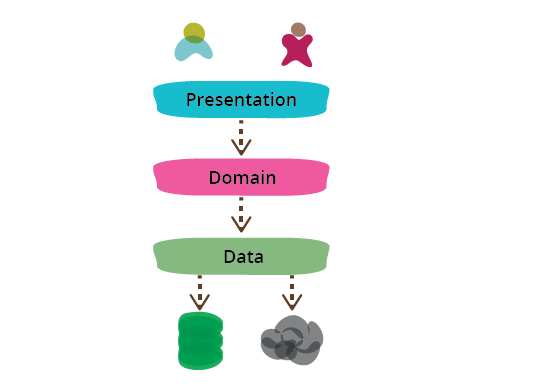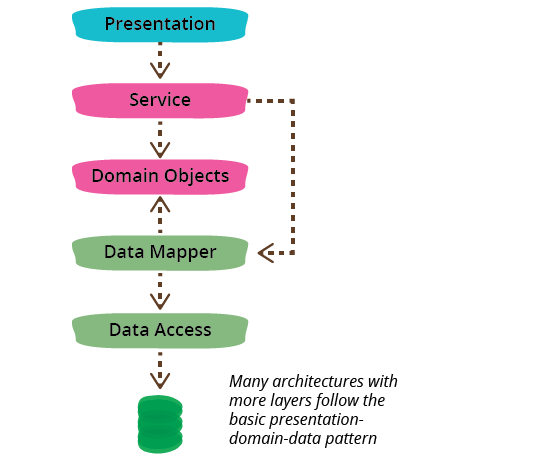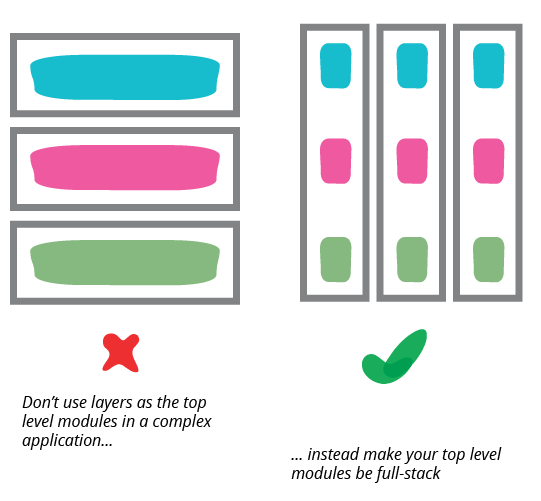Presentation Domain Data Layering
26 August 2015
One of the most common ways to modularize an information-rich program is to separate it into three broad layers: presentation (UI), domain logic (aka business logic), and data access. So you often see web applications divided into a web layer that knows about handling HTTP requests and rendering HTML, a business logic layer that contains validations and calculations, and a data access layer that sorts out how to manage persistent data in a database or remote services.

On the whole I've found this to be an effective form of modularization for many applications and one that I regularly use and encourage. It's biggest advantage (for me) is that it allows me to reduce the scope of my attention by allowing me to think about the three topics relatively independently. When I'm working on domain logic code I can mostly ignore the UI and treat any interaction with data sources as an abstract set of functions that give me the data I need and update it as I wish. When I'm working on the data access layer I focus on the details of wrangling the data into the form required by my interface. When I'm working on the presentation I can focus on the UI behavior, treating any data to display or update as magically appearing by function calls. By separating these elements I narrow the scope of my thinking in each piece, which makes it easier for me to follow what I need to do.
This narrowing of scope doesn't imply any sequence to programming them - I usually find I need to iterate between the layers. I might build the data and domain layers off my initial understanding of the UX, but when refining the UX I need to change the domain which necessitates a change to the data layer. But even with that kind of cross-layer iteration, I find it easier to focus on one layer at a time as I make changes. It's similar to the switching of thinking modes you get with refactoring's two hats.
Another reason to modularize is to allow me to substitute different implementations of modules. This separation allows me to build multiple presentations on top of the same domain logic without duplicating it. Multiple presentations could be separate pages in a web app, having a web app plus mobile native apps, an API for scripting purposes, or even an old fashioned command line interface. Modularizing the data source allows me to cope gracefully with a change in database technology, or to support services for persistence that may change with little notice. However I have to mention that while I often hear about data access substitution being a driver for separating the data source layer, I rarely hear of someone actually doing it.
Modularity also supports testability, which naturally appeals to me as a big fan of SelfTestingCode. Module boundaries expose seams that are good affordance for testing. UI code is often tricky to test, so it's good to get as much logic as you can into a domain layer which is easily tested without having to do gymnastics to access the program through a UI 1. Data access is often slow and awkward, so using TestDoubles around the data layer often makes domain logic testing much easier and responsive.
1: A PageObject is also an important tool to help testing around UIs.
While substitutability and testability are certainly benefits of this layering, I must stress that even without either of these reasons I would still divide into layers like this. The reduced scope of attention reason is sufficient on its own.
When talking about this we can either look at it as one pattern (presentation-domain-data) or split it into two patterns (presentation-domain, and domain-data). Both points of view are useful - I think of presentation-domain-data as a composite of presentation-domain and domain-data.
I consider these layers to be a form of module, which is a generic word I use for how we clump our software into relatively independent pieces. Exactly how this corresponds to code depends on the programming environment we're in. Usually the lowest level is some form of subroutine or function. An object-oriented language will have a notion of class that collects functions and data structure. Most languages have some form of higher level called packages or namespaces, which often can be formed into a hierarchy. Modules may correspond to separately deployable units: libraries, or services, but they don't have to.
Layering can occur at any of these levels. A small program may just put separate functions for the layers into different files. A larger system may have layers corresponding to namespaces with many classes in each.
I've mentioned three layers here, but it's common to see architectures with more than three layers. A common variation is to put a service layer between the domain and presentation, or to split the presentation layer into separate layers with something like Presentation Model. I don't find that more layers breaks the essential pattern, since the core separations still remain.

The dependencies generally run from top to bottom through the layer stack: presentation depends on the domain, which then depends on the data source. A common variation is to arrange things so that the domain does not depend on its data sources by introducing a mapper between the domain and data source layers. This approach is often referred to as a Hexagonal Architecture.
These layers are logical layers not physical tiers. I can run all three layers on my laptop, I can run the presentation and domain model in a desktop with a database on a server, I can split the presentation with a rich client in the browser and a Backed For Frontend on the server. In that case I treat the BFF as a presentation layer as it's focused on supporting a particular presentation option.
Although presentation-domain-data separation is a common approach, it should only be applied at a relatively small granularity. As an application grows, each layer can get sufficiently complex on its own that you need to modularize further. When this happens it's usually not best to use presentation-domain-data as the higher level of modules. Often frameworks encourage you to have something like view-model-data as the top level namespaces; that's OK for smaller systems, but once any of these layers gets too big you should split your top level into domain oriented modules which are internally layered.

Developers don't have to be full-stack but teams should be.
One common way I've seen this layering lead organizations astray is the AntiPattern of separating development teams by these layers. This looks appealing because front-end and back-end development require different frameworks (or even languages) making it easy for developers to specialize in one or the other. Putting those people with common skills together supports skill sharing and allows the organization to treat the team as a provider of a single, well-delineated type of work. In the same way, putting all the database specialists together fits in with the common centralization of databases and schemas. But the rich interplay between these layers necessitates frequent swapping between them. This isn't too hard when you have specialists in the same team who can casually collaborate, but team boundaries add considerable friction, as well as reducing an individual's motivation to develop the important cross-layer understanding of a system. Worse, separating the layers into teams adds distance between developers and users. Developers don't have to be full-stack (although that is laudable) but teams should be.
Further Reading
I've written about this separation from a number of different angles elsewhere. This layering drives the structure of P of EAA and chapter 1 of that book talks more about this layering. I didn't make this layering a pattern in its own right in that book but have toyed with that territory with Separated Presentation and PresentationDomainSeparation.
For more on why presentation-domain-data shouldn't be the highest level modules in a larger system, take a look at the writing and speaking of Simon Brown. I also agree with him that software architecture should be embedded in code.
I had a fascinating discussion with my colleague Badri Janakiraman about the nature of hexagonal architectures. The context was mostly around applications using Ruby on Rails, but much of the thinking applies to other cases when you may be considering this approach.
Acknowledgements
James Lewis, Jeroen Soeters, Marcos Brizeno, Rouan Wilsenach, and Sean Newham discussed drafts of this post with me.Notes
1: A PageObject is also an important tool to help testing around UIs.

